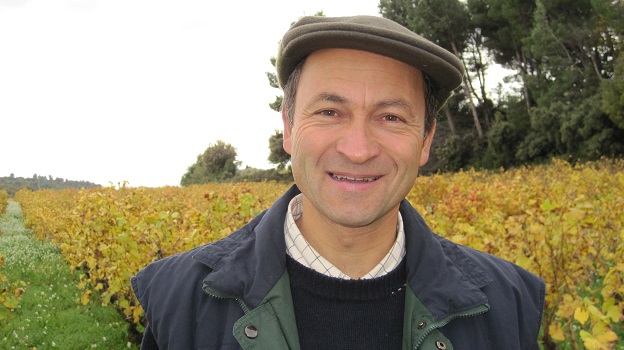Châteauneuf du Pape: The Lively 2013s and Lush 2012s
Producers in Châteauneuf-du-Pape have been cursed with shorter crops than usual in recent vintages but 2013 took production to a new low. Yields were off by as much as 75% for growers whose vineyards are planted heavily with Grenache, which of course means nearly everybody. So there has been plenty of angst to spread around.

Emmanuel Reyanud in the vines outside Rayas' front door
The 2013 Growing Season and Wines
The culprit in 2013, as in 2012, was a cold spring that delayed the flowering, with temperatures even more frigid than in 2012—so much so that many older vines, mostly Grenache, produced no fruit at all and, in the worst cases, actually died. Temperatures often hovered near freezing into May, which is virtually unprecedented in the region. It was also exceptionally wet through the spring, with total rainfall of 217 millimeters in the March through May period (compared to 165 in 2012, 17 in 2011 and 107 in 2010). For earlier-flowering varieties like Grenache, that’s a perfect storm for disaster, and paltry yields were the result. Fortunately, Mourvèdre and Syrah, which flower later than Grenache, were relatively unscathed.
Producers in Châteauneuf-du-Pape have been cursed with shorter crops than usual in recent vintages but 2013 took production to a new low. Yields were off by as much as 75% for growers whose vineyards are planted heavily with Grenache, which of course means nearly everybody. The best 2013 Châteauneufs offer an intriguing blend of vivacity (a result of the later ripening season, which helped to maintain acidity levels) and dark fruit character (because of the increased reliance on Mourvèdre and Syrah).
Show all the wines (sorted by score)
Producers in this Article
- Arnoux et Fils
- Auguste Bessac
- Bosquet des Papes
- Brotte
- Caves Saint-Pierre
- Cellier des Princes
- Chapelle St. Théodoric
- Château Beauchêne
- Château Cabrières
- Château de Beaucastel
- Château de la Gardine
- Château de la Grande Gardiole
- Château de Manissy
- Château des Fines Roches
- Château de Vaudieu
- Château Fargueirol
- Château Fortia
- Château Gigognan
- Château Jas de Bressy
- Château La Nerthe
- Château Maucoil
- Château Mongin
- Château Mont-Redon
- Château Mont-Thabor
- Château Rayas
- Château Saint-Jean
- Château Saint-Roch-Brunel
- Château Simian
- Château Sixtine
- Christophe Mestre
- Clos de l'Oratoire des Papes
- Clos des Brusquières
- Clos des Papes
- Clos du Calvaire
- Clos du Mont-Olivet
- Clos Saint-Jean
- Clos Saint-Michel
- Cuvée du Vatican
- Delas Frères
- Domaine Albin Jacumin
- Domaine Berthet-Rayne
- Domaine Bois de Boursan
- Domaine Brunely
- Domaine Chante Cigale
- Domaine Chante-Perdrix
- Domaine Charvin
- Domaine Comte de Lauze
- Domaine de Beaurenard
- Domaine de Châteaumar
- Domaine de Cristia
- Domaine de Ferrand
- Domaine de Fontavin
- Domaine de la Biscarelle
- Domaine de la Charbonnière
- Domaine de la Côte de l'Ange
- Domaine de la Croze-Granier
- Domaine de la Janasse
- Domaine de la Mordorée
- Domaine de L'Arnesque
- Domaine de la Roncière
- Domaine de la Solitude
- Domaine de la Vieille Julienne
- Domaine de l'Harmas
- Domaine de Marcoux
- Domaine de Mourchon
- Domaine de Nalys
- Domaine de Panisse
- Domaine de Pignan
- Domaine des 3 Cellier
- Domaine de Saint Siffrein
- Domaine des Saumades
- Domaine des Sénéchaux
- Domaine de Villeneuve
- Domaine du Banneret
- Domaine du Bois de Saint-Jean
- Domaine Duclaux
- Domaine du Grand Tinel
- Domaine du Pegau
- Domaine du Père Caboche
- Domaine du Père Pape
- Domaine Durieu
- Domaine Duseigneur
- Domaine du Vieux Lazaret
- Domaine du Vieux Télégraphe
- Domaine Font de Michelle
- Domaine Galévan
- Domaine Giraud
- Domaine Grand Veneur
- Domaine Henri Bonneau
- Domaine Isabel Ferrando
- Domaine Jean Royer
- Domaine Jérôme Gradassi
- Domaine Julien Masquin
- Domaine Juliette Avril
- Domaine La Barroche
- Domaine L'Abbé Dîne
- Domaine La Boutinière
- Domaine La Consonnière
- Domaine Lafond Roc-Epine
- Domaine La Mereuille
- Domaine La Millière
- Domaine La Roquète
- Domaine Le Mourre
- Domaine Le Pointu
- Domaine Les Semelles de Vent
- Domaine Mas Saint-Louis
- Domaine Mathieu
- Domaine Olivier Hillaire
- Domaine Patrice Magni
- Domaine Paul Autard
- Domaine Pierre Usseglio
- Domaine Pontifical
- Domaine Porte Rouge
- Domaine Raymond Usseglio & Fils
- Domaine Roche-Audran
- Domaine Roger Perrin
- Domaine Roger Sabon
- Domaine Saint-Paul
- Domaine Saint-Préfert
- Domaine Santa Duc
- Domaine Serguier
- Domaine Tourbillon
- Domaine Tour Saint-Michel
- Eddie Féraud
- E. Guigal
- Éric Texier
- Famille Perrin
- Famille Tardieu (Tardieu-Laurent)
- Féraud-Brunel
- Ferraton Père & Fils
- Gabriel Meffre
- Georges Lelektsoglou
- Grandes Serres
- La Bastide Saint-Dominique
- La Celestière
- La Crau de Ma Mère
- La Fagotière
- Lavau
- Le Bois Pointu
- Le Clos du Caillou
- Les Cailloux
- Les Granges des Papes
- Les Halos de Jupiter
- Les Trois Couronnes
- Le Vieux Donjon
- Louis Bernard
- Maison Bouachon
- Maison Chapoutier
- Mas de Boislauzon
- Ogier
- Olivier & Lafont
- Olivier Ravoire
- Paul Jaboulet Aîné
- Pierre-Henri Morel
- Pierre Vidal
- Rotem & Mounir Saouma
- Saint-Cosme